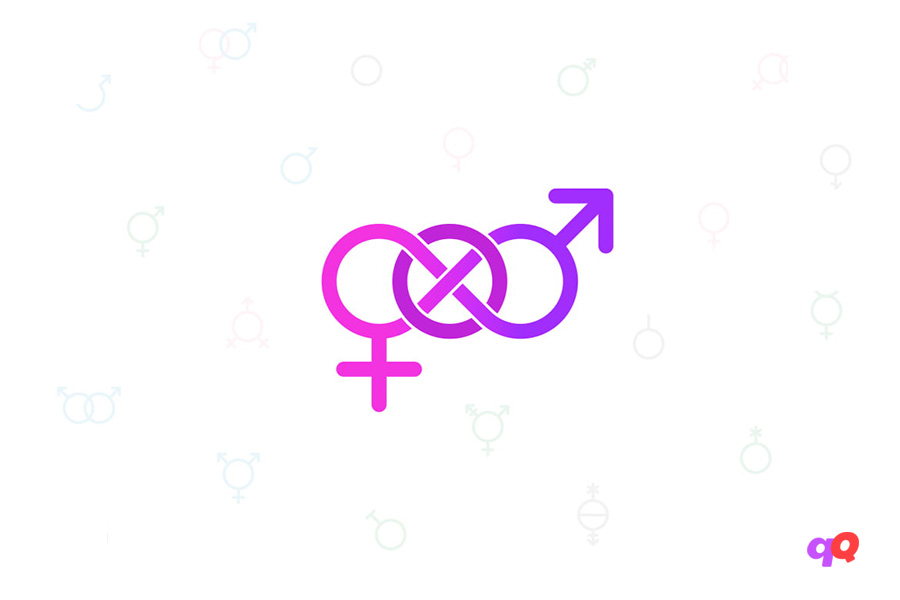Sexuality Quiz: Fluid, Fixed, or Finding Out?
○ DISCLAIMER
The quizzes and content on this website are designed for entertainment purposes only and should not be used as a basis for making personal decisions about your sexuality, gender identity, or any other life choices. These quizzes are not diagnostic tools and cannot determine your identity or orientation. If you're questioning your identity or need support, we strongly encourage you to seek guidance from qualified LGBTQ+ friendly professionals or counselors. Remember that your journey of self-discovery is unique and personal to you.

“Who am I?” – this question often emerges during moments of quiet contemplation when we find ourselves alone with our thoughts. In such moments, many people open a tab with an online sexuality quiz, hoping to find clues to unlock their own identity. How and why has this particular format of self-discovery become the first step toward self-understanding for many? The fact is that sexuality isn’t just a set of categories, but rather a unique spectrum of feelings and experiences that deserves deep and thoughtful exploration.
What is Sexuality?
Sexuality is a fundamental aspect of human nature that manifests long before adolescence and continues to develop throughout life. It’s a complex interweaving of biological processes, psychological states, and social interactions. In the scientific community, sexuality is typically viewed as a spectrum, where different orientations represent natural variations of human experience.
The history of sexuality research is rich with discoveries and contradictions. From the works of Sigmund Freud and Alfred Kinsey to modern neurobiology research – our understanding of this aspect of human nature continues to deepen. Today, we know that sexuality encompasses many components: from hormonal background to cultural norms, from genetic predisposition to personal experience.
Heterosexuality
Heterosexuality, being the statistically predominant orientation, is often perceived as the “norm,” which creates certain social prerequisites. Interestingly, the very concept of heterosexuality as a separate category only emerged in the 19th century when the need arose to classify different forms of sexual behavior.
Different cultures regulate heterosexual relationships through various norms and traditions. For example, some societies have strict courtship rules, while others welcome more free expression of feelings. The concept of heterosexuality itself can include a wide spectrum of preferences and attraction characteristics.
Homosexuality
The history of attitudes toward homosexuality reflects the evolution of social consciousness. In Ancient Greece, same-sex relationships were integrated into the social structure. In Ancient Rome, same-sex marriages even existed until they were banned by Emperor Constantine. During the Renaissance, homosexuality was closely linked with art and culture, although officially persecuted by the church.
Modern research shows that homosexuality occurs in many animal species, confirming its natural origin. For instance, scientists have observed same-sex behavior in more than 1,500 species, from primates to birds.
Bisexuality
Bisexuality often becomes subject to misunderstanding even within the LGBTQ+ community. There exists a phenomenon of “biphobia” – prejudice against bisexual people from both heterosexual and homosexual communities. Research shows that bisexual people may experience varying intensities of attraction to different genders during different life periods, which doesn’t make their orientation any less valid.
Interestingly, the “Kinsey Scale” concept, developed in 1948, already suggested the existence of various gradations between exclusive heterosexuality and homosexuality. Modern researchers propose even more complex models to describe the bisexual spectrum.
Asexuality
Asexuality long remained invisible in a society where sexual attraction is considered the norm. Today, we know that about 1% of the population identifies as asexual. Asexuality also represents a spectrum: some asexual people may experience romantic feelings, while others don’t. There exists the concept of “gray asexuality,” where a person experiences sexual attraction very rarely or under special circumstances.
Research shows that asexual people can lead fulfilling social lives and build deep interpersonal relationships based on other forms of intimacy. The asexual community has developed a rich vocabulary to describe various types of attachment and attraction not related to sexual desire.
Pansexuality
Pansexuality is a relatively new term that reflects the modern understanding of gender as a spectrum rather than a binary system. Pansexual people can experience attraction to someone regardless of their gender identity, which differs from bisexuality, where a partner’s gender may play a role in the nature of attraction.
It’s interesting to trace how the understanding of pansexuality has evolved in the context of growing awareness of gender diversity. This term became particularly relevant in an era when society began recognizing the existence of non-binary, genderfluid, and other identities.
Demisexuality
The concept of demisexuality emerged in the early 2000s within internet communities discussing the asexual spectrum. Demisexual people can experience sexual attraction only after forming a deep emotional connection, which distinguishes them from both asexual and allosexual people (those who regularly experience sexual attraction).
It’s important to note that the time needed to form an emotional connection can vary among different demisexual people. Some may need months or even years, while others might require just a few weeks of intensive communication.
Omnisexuality
Omnisexuality is often confused with pansexuality, but there is a significant difference between them. Omnisexual people consciously note the gender of potential partners and may experience different types of attraction to people of different gender identities. However, gender isn’t a limiting factor but rather an additional aspect of attractiveness.
The Influence of Culture and Society
Cultural context plays an enormous role in how people perceive and express their sexuality. Different societies have unique concepts of gender and sexuality. For example, Native American cultures have the concept of “two-spirit” – a special gender identity that includes both male and female spiritual qualities.
History knows examples of societies where sexuality was viewed quite differently than in the modern Western world. In ancient Mesopotamia, there were temple servants whose sexuality was considered sacred. Some Polynesian cultures had complex systems of sexual taboos and privileges related to social status.
Is Sexual Orientation Fluid?
The concept of sexual fluidity, introduced by researcher Lisa Diamond, revolutionized our understanding of sexuality. Based on long-term studies, she showed that sexual preferences can change over time for some people, especially women. This doesn’t mean orientation is consciously “chosen” – rather, it’s about the natural dynamics of sexuality.
Interestingly, the degree of fluidity can vary among different people. Some note stability in their preferences throughout life, while others observe changes depending on life circumstances, emotional state, or encounters with specific people.
How Can a Sexuality Quiz Help?
A sexuality quiz represents a tool for self-exploration that helps draw attention to various aspects of one’s feelings and preferences. By answering questions, a person may notice patterns in their emotional and physical experiences that might have previously gone unnoticed.
The process of taking the quiz can become a starting point for deeper self-knowledge. It’s important to understand that quiz results are not a diagnosis or final verdict, but rather an invitation to reflect on various aspects of one’s personality.
Accepting Your Sexual Orientation
In modern society, the process of accepting one’s sexual orientation can be complicated due to persistent prejudices and stereotypes. History knows many examples of how public opinion gradually shifted toward greater tolerance. For instance, homosexuality was removed from the American Psychiatric Association’s list of mental disorders in 1973, which became an important milestone in recognizing various forms of sexuality.
It’s interesting to note that the process of self-acceptance often includes several stages: from initial awareness through a period of doubt and exploration to integrating one’s identity into a complete picture of personality. Each person goes through this journey at their own pace and in their own unique way.
In the modern world, we observe a gradual movement toward a deeper understanding of human sexuality in all its diversity. Scientific research continues to uncover new aspects of this complex phenomenon, and society gradually learns to accept various forms of its manifestation. It’s important to remember that every person has the right to self-determination and respectful treatment of their identity, whatever it may be.
○ Related Quizzes
Questions Overview
- Building a deep emotional connection
- Mutual attraction and romance
- Ability to be yourself with your partner
- Comfortable interaction without pressure
- Prefer meeting through friends
- Open to different options
- Could be an interesting experience
- Enjoy meeting new people
- Their personal history and character
- A special spark in their eyes
- Inner freedom and authenticity
- Interesting inner world
- Based on friendship and understanding
- With complete acceptance and support
- Where there's room for growth
- With deep emotional connection
- Need time for true closeness
- Important to feel constant connection
- Depends on emotional bond
- Value stability and growth
- Desire for special connection
- Interest in new possibilities
- Complex mixed feelings
- Calm contemplation
- Only with deep connection
- In rare special moments
- It's hard to define
- Regularly, to different people
- Deep emotional unity
- Natural progression of feelings
- Special way of knowing each other
- Spiritual closeness
- Get shy and distant
- With curiosity and interest
- Differently, depends on the person
- Evaluate intentions
- Based on friendship
- With deep emotional connection
- Open and honest
- Filled with romance
- Getting to know someone over time
- Special chemistry between us
- Uniqueness of personality
- Unexpected matching of views
- Each relationship is unique
- They limit freedom of feelings
- Don't fit into them
- Relationships are deeper than stereotypes
- Ability for deep contact
- Special energy
- Inner freedom
- Sincerity of feelings
- It's part of deep relationships
- Important aspect of connection
- Depends on situation
- Prefer other forms of closeness
- Rushed physical intimacy
- Meeting expectations
- Maintaining personal boundaries
- Expressing feelings
- Through extended communication
- A special feeling appears
- It's always different
- Rarely experience attraction
- Social expectations
- Stereotypical roles
- Physical intimacy
- External success attributes
- Ability to be yourself
- Mutual growth
- Understanding without words
- Respect for each other's uniqueness
- Almost never change
- Depends on connection with person
- Constantly exploring myself
- Naturally evolve
- Pressure for intimacy
- Insincerity of feelings
- Following stereotypes
- Superficial communication
- Emotional safety is important
- Depends on relationship development
- Value stability
- Sincerity of feelings matters most
- Deep mutual understanding
- Special attraction
- Unique compatibility
- Comfort in communication
- With caution and attention
- As part of development
- Explore new facets
- Important to maintain stability
- Capacity for deep connection
- Sincerity of feelings
- Acceptance of different love expressions
- Respect for personal boundaries







